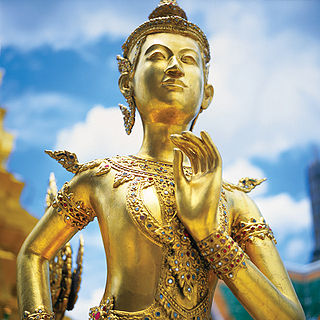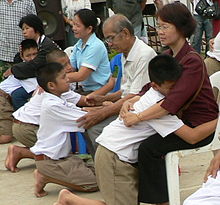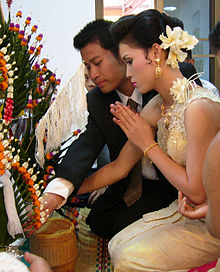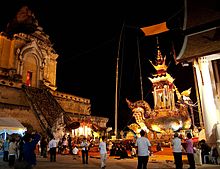- Culture of Thailand
-
The Culture of Thailand incorporates cultural beliefs and characteristics indigenous to the area known as modern day Thailand coupled with much influence from ancient India, China, Cambodia, along with the neighbouring pre-historic cultures of Southeast Asia. It is influenced primarily by Animism, Hinduism, Buddhism, as well as by later migrations from China, and southern India.
Contents
Arts
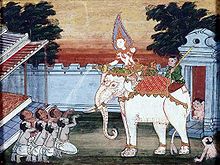 A depiction of a white elephant in 19th century Thai art
A depiction of a white elephant in 19th century Thai art Main article: Thai art
Main article: Thai artThai visual art was traditionally primarily Buddhist. Thai Buddha images from different periods have a number of distinctive styles. Thai temple art and architecture evolved from a number of sources, one of them being Khmer architecture. Contemporary Thai art often combines traditional Thai elements with modern techniques.
Literature in Thailand is heavily influenced by Indian Hindu culture. The most notable works of Thai literature are a version of the Ramayana, a Hindu religious epic, called the Ramakien, written in part by Kings Rama I and Rama II, and the poetry of Sunthorn Phu.
There is no tradition of spoken drama in Thailand, the role instead being filled by Thai dance. This is divided into three categories- khon, lakhon and likay- khon being the most elaborate and likay the most popular. Nang drama, a form of shadow play, is found in the south.
The music of Thailand includes classical and folk music traditions as well as string or pop music.
Religion
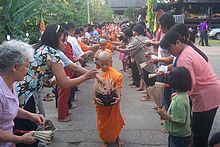 Young buddhist monks receiving joss sticks
Young buddhist monks receiving joss sticks Main article: Religion in Thailand
Main article: Religion in ThailandThailand is nearly 95% Theravada Buddhist (which includes the Thai Forest Tradition and the Dhammayuttika Nikaya and Santi Asoke sects,) with minorities of Muslims (4.6%), Christians (0.7%), Mahayana Buddhists, and other religions.[1] Thai Theravada Buddhism is supported and overseen by the government, with monks receiving a number of government benefits, such as free use of the public transportation infrastructure.
Buddhism in Thailand is strongly influenced by traditional beliefs regarding ancestral and natural spirits, which have been incorporated into Buddhist cosmology. Most Thai people own spirit houses, miniature wooden houses in which they believe household spirits live. They present offerings of food and drink to these spirits to keep them happy. If these spirits aren't happy, it is believed that they will inhabit the larger household of the Thai, and cause chaos. These spirit houses can be found in public places and in the streets of Thailand, where the public make offerings.[2]
Prior to the rise of Theravada Buddhism, both Indian Brahmanic religion and Mahayana Buddhism were present in Thailand. Influences from both these traditions can still be seen in the present day. Brahmanist shrines play an important role in Thai folk religion, and the Mahayana Buddhist influence is reflected in the presence of figures like Lokesvara, a form of the bodhisattva Avalokitesvara sometimes incorporated into Thailand's iconography.[3][4]
Cuisine
 Kaeng phet pet yang: roast duck in red curry
Kaeng phet pet yang: roast duck in red curry Main article: Thai cuisine
Main article: Thai cuisineThai cuisine is famous for the blending of four fundamental tastes:
- sweet (sugar, fruits)
- spicy hot (chilies)
- sour (lime juice, tamarind)
- salty (fish sauce, soy sauce)
Some of the dishes in Thai cuisine try to combine many, if not most, of these flavors. This is accomplished by using a host of herbs, spices and fruit, including: chili, galangal, garlic, lime leaves, basil, sweet basil, lime, lemongrass, coriander, pepper, turmeric, and shallot as well as vinegar and sugar. Some dishes are somewhat bland and flavored to taste by the person eating the dish, for example khao dtom (rice soup), jok (rice porridge), guay dtieow (rice noodles).
On the other hand there are many dishes which are not spicy, sour, sweet or salty, and are meant to be savory and bland. Khao man gai, khao ka mu, khao mu graub, etc.
Sports
The most popular team sport in Thailand is football (also known as association football or soccer). However, the professional leagues Thai League and Pro League in Thailand are in their infancy. The English Premiership has a large following in Thailand. Muay Thai (Thai boxing) is probably the most popular spectator sport in Thailand. The other main indigenous sport is takraw, which is similar to volleyball, but played with their feet and a light rattan ball. There are several versions of the game with differing rules.
There is a Swan Boat circuit where the villages field teams compete. The international invitational race is usually in November.
Egg rolling once enjoyed national-pastime status, but famine and egg shortages around the middle of the last century caused it to retreat to rural villages, where it is still practiced with traditional vigour.[citation needed]
Customs
 Thai greeting. The smile is an important symbol of refinement in Thai culture
Thai greeting. The smile is an important symbol of refinement in Thai culture
The traditional customs of Thai people were gathered and described by Phya Anuman Rajadhon in the 20th century, at a time when modernity changed the face of Thailand and a great number of traditions disappeared or became adapted to modern life. Still, the strife towards refinement, rooted in ancient Siamese culture, consisting in promoting what is refined and avoiding coarseness is the main emphasis in the daily life of all Thai people and topmost in their scale of values.[5]
One of the most distinctive Thai customs is the wai. Showing greeting, farewell, or acknowledgement, it comes in several forms reflecting the relative status of those involved. Generally the salutation involves a prayer-like gesture with the hands, similar to the Añjali Mudrā of the Indian Subcontinent, and it also may include a slight bow of the head. This salutation is often accompanied by a serene smile symbolizing a welcoming disposition and a pleasant attitude. Thailand is often referred to as the "Land of Smiles" in tourist brochures.
Public display of affection in public is not common in traditional Thai society, especially between lovers. Friends may be seen walking together holding hands, but couples rarely do so except in Westernized areas.
A notable social norm holds that touching someone on the head may be considered rude. It is also considered rude to place one's feet at a level above someone else's head, especially if that person is of higher social standing. This is because the Thai people consider the foot to be the dirtiest and lowliest part of the body, and the head the most respected and highest part of the body. This also influences how Thais sit when on the ground—their feet always pointing away from others, tucked to the side or behind them. Pointing at or touching something with the feet is also considered rude.
Since serene detachment is valued, conflict and sudden displays of anger are eschewed in Thai culture and, as is many Asian cultures, the notion of face is extremely important. For these reasons, visitors should take care not to create conflict, to display anger or to cause a Thai person to lose face. Disagreements or disputes should be handled with a smile and no attempt should be made to assign blame to another. In everyday life in Thailand, there is a strong emphasis on the concept of sanuk'; the idea that life should be fun. Because of this, Thai can be quite playful at work and during day-to-day activities. Displaying positive emotions in social interactions is also important in Thai culture. Often, the Thai will deal with disagreements, minor mistakes or misfortunes by using the phrase "mai pen rai", translated as "it doesn't matter". The ubiquitous use of this phrase in Thailand reflects a disposition towards minimizing conflict, disagreements or complaints. A smile and the sentence "mai pen rai" indicate that the incident is not important and therefore there is no conflict or shame involved.
Respect for hierarchy is a very important value for Thai people. The custom of bun khun, emphasizes the indebtedness towards parents, as well as towards guardians, teachers and caretakers. It describes the feelings and practices involved in certain relationships organized around generalized reciprocity, the slow-acting accounting of an exchange calculated according to locally interpreted scales and measures.[6] It is also considered extremely rude to step on a Thai coin, because the king's head appears on the coin.
There are a number of Thai customs relating to the special status of monks in Thai society. Due to religious discipline, Thai monks are forbidden physical contact with women. Women are therefore expected to make way for passing monks to ensure that accidental contact does not occur. A variety of methods are employed to ensure that no incidental contact (or the appearance of such contact) between women and monks occurs. Women making offerings to monks place their donation at the feet of the monk, or on a cloth laid on the ground or a table. Powders or unguents intended to carry a blessing are applied to Thai women by monks using the end of a candle or stick. Lay people are expected to sit or stand with their heads at a lower level than that of a monk. Within a temple, monks may sit on a raised platform during ceremonies to make this easier to achieve.
When sitting in a temple, one is expected to point one's feet away from images of the Buddha. Shrines inside Thai residences are arranged so as to ensure that the feet are not pointed towards the religious icons—such as placing the shrine on the same wall as the head of a bed, if a house is too small to remove the shrine from the bedroom entirely. It is also customary to remove one's footwear before entering a home or the sacred areas within a temple, and not to step on the threshold.
Marriage
A wedding in Thailand Main article: Thai marriage
Main article: Thai marriageThai marriage ceremonies between Buddhists are generally divided into two parts: a Buddhist component, which includes the recitation of prayers and the offering of food and other gifts to monks and images of the Buddha, and a non-Buddhist component rooted in folk traditions, which centers on the couple's family.
In former times, it was unknown for Buddhist monks to be present at any stage of the marriage ceremony itself. As monks were required to attend to the dead during funerals, their presence at a marriage (which was associated with fertility, and intended to produce children) was considered a bad omen. A couple would seek a blessing from their local temple before or after being married, and might consult a monk for astrological advice in setting an auspicious date for the wedding. The non-Buddhist portions of the wedding would take place away from the temple, and would often take place on a separate day.
In modern times, these prohibitions have been significantly relaxed. It is not uncommon for a visit to a temple to be made on the same day as the non-Buddhist portions of a wedding, or even for the wedding to take place within the temple. While a division is still commonly observed between the "religious" and "secular" portions of a wedding service, it may be as simple as the monks present for the Buddhist ceremony departing to take lunch once their role is complete.
During the Buddhist component of the wedding service, the couple first bow before the image of the Buddha. They then recite certain basic Buddhist prayers or chants (typically including taking the Three Refuges and the Five Precepts), and light incense and candles before the image. The parents of the couple may then be called upon to 'connect' them, by placing upon the heads of the bride and groom twin loops of string or thread that link the couple together. The couple may then make offerings of food, flowers, and medicine to the monks present. Cash gifts (usually placed in an envelope) may also be presented to the temple at this time.
The monks may then unwind a small length of thread that is held between the hands of the assembled monks. They begin a series of recitations of Pali scriptures intended to bring merit and blessings to the new couple. The string terminates with the lead monk, who may connect it to a container of water that will be 'sanctified' for the ceremony. Merit is said to travel through the string and be conveyed to the water; a similar arrangement is used to transfer merit to the dead at a funeral, further evidence of the weakening of the taboo on mixing funerary imagery and trappings with marriage ceremonies. Blessed water may be mixed with wax drippings from a candle lit before the Buddha image and other unguents and herbs to create a 'paste' that is then applied to the foreheads of the bride and groom to create a small 'dot', similar to the marking sometimes made with red ochre on Hindu devotees. The bride's mark is created with the butt end of the candle rather than the monk's thumb, in keeping with the Vinaya prohibition against touching women.
The highest-ranking monk present may elect to say a few words to the couple, offering advice or encouragement. The couple may then make offerings of food to the monks, at which point the Buddhist portion of the ceremony is concluded.
The Thai dowry system is known as the 'Sin Sodt'. Traditionally, the groom will be expected to pay a sum of money to the family, to compensate them and to demonstrate that the groom is financially capable of taking care of their daughter. Sometimes, this sum is purely symbolic, and will be returned to the bride and groom after the wedding has taken place.
The religious component of marriage ceremonies between Thai Muslims are markedly different from that described above. The Imam of the local mosque, the groom, the father of the bride, men in the immediate family and important men in the community sit in a circle during the ceremony, conducted by the Imam. All the women, including the bride, sit in a separate room and do not have any direct participation in the ceremony. The secular component of the ceremony, however, is often nearly identical to the secular part of Thai Buddhist wedding ceremonies. The only notable difference here is the type of meat served to guests (goat and/or beef instead of pork). Thai Muslims frequently, though not always, also follow the conventions of the Thai dowry system.
Birth Traditions and Beliefs
Main article: Birth in ThailandFunerals
Traditionally funerals last for a week. Crying is discouraged during the funeral, so as not to worry the spirit of the deceased. Many activities surrounding the funeral are intended to make merit for the deceased. Copies of Buddhist scriptures may be printed and distributed in the name of the deceased, and gifts are usually given to a local temple. Monks are invited to chant prayers that are intended to provide merit for the deceased, as well as to provide protection against the possibility of the dead relative returning as a malicious spirit. A picture of the deceased from his/her best days will often be displayed next to the coffin. Often, a thread is connected to the corpse or coffin which is held by the chanting monks during their recitation; this thread is intended to transfer the merit of the monks' recitation to the deceased. The corpse is cremated, and the urn with the ash is usually kept in a chedi in the local temple. The Chinese minority however bury the deceased.
Holidays
Main article: Public holidays in ThailandImportant holidays in Thai culture include Thai New Year, or Songkran, which is officially observed from April 13 to 15 each year. Falling at the end of the dry season and during the hot season in Thailand, the celebrations notoriously feature boisterous water throwing. The water throwing stemmed from washing Buddha images and lightly sprinkling scented water on the hands of elderly people. Small amounts of scented talcum powder were also used in the annual cleansing rite. But in recent decades the use of water has intensified with the use of hoses, barrels, squirt guns, high-pressure tubes and copious amounts of powder.
Another holiday is Loi Krathong, which is held on the 12 full moon of the Thai lunar calendar. While not a government-observed holiday, it is nonetheless an auspicious day in Thai culture, in which Thai people "loi", meaning "to float" a "krathong", a small raft traditionally made from a section of banana tree, decorated with elaborately-folded banana leaves, flowers, candles, incense sticks etc. The act of floating away the candle raft is symbolic of letting go of all one's grudges, anger and defilements, so that one can start life afresh on a better foot.
Nicknames
See also: Thai namesThais universally have one, or occasionally more, short nicknames (Thai: ชึ่อเล่น play-name) that they use with friends and family. Often first given by friends or an older family member, these nicknames are typically one syllable (or worn down from two syllables to one). Though they may be simply shortened versions of a full name, they quite frequently have no relation to the Thai’s full name and are often humorous and/or nonsense words. Traditionally call-names would be after things with low value, eg 'dirt', which was to convince evil spirits lurking in the vicinity that the child was not worth their attention.
Some common nicknames would translate into English as small, fatty, pig, little one, frog, banana, green, or girl/boy. Though rare, sometimes Thai children are given nicknames after the order they were born into the family (i.e. one, two, three, etc.). Nicknames are useful because official Thai names are often long, particularly among Thais of Chinese descent, whose lengthy names stem from an attempt to translate Chinese names into Thai equivalents, or among Thai with similarly lengthy Sanskrit-derived names.
See also
- Cinema of Thailand
- Media of Thailand
- Ministry of Culture (Thailand)
- Phya Anuman Rajadhon
- Royal Flags of Thailand
- Thailand National Artist
- Thai temple art and architecture
Notes and references
- ^ "CIA World Factbook: Thailand". Central Intelligence Agency. 2007-02-08. https://www.cia.gov/library/publications/the-world-factbook/geos/th.html. Retrieved 2007-03-07.
- ^ Philip Cornwell-Smith: Very Thai, page 182. River Books, 2005.
- ^ http://www.buddhist-elibrary.org/library/view.php?adpath=164 Buddhist Arts of Thailand, Ms Charuwan Chareonla
- ^ Philip Cornwell-Smith: Very Thai, page 184. River Books, 2005.
- ^ Phya Anuman Rajadhon, Life and Ritual in Old Siam: Three Studies of Thai Life and Customs, New Haven, HRAF Press, 1961
- ^ Wilson, Ara (2004). Intimate Economies of Bangkok: Tomboys, Tycoons, and Avon Ladies in the Global City. Berkeley and Los Angeles: University of California. ISBN 9780520239685.
External links
Culture of Southeast Asia Culture of Asia Sovereign
states- Afghanistan
- Armenia
- Azerbaijan
- Bahrain
- Bangladesh
- Bhutan
- Brunei
- Burma (Myanmar)
- Cambodia
- People's Republic of China
- Cyprus
- East Timor (Timor-Leste)
- Egypt
- Georgia
- India
- Indonesia
- Iran
- Iraq
- Israel
- Japan
- Jordan
- Kazakhstan
- North Korea
- South Korea
- Kuwait
- Kyrgyzstan
- Laos
- Lebanon
- Malaysia
- Maldives
- Mongolia
- Nepal
- Oman
- Pakistan
- Philippines
- Qatar
- Russia
- Saudi Arabia
- Singapore
- Sri Lanka
- Syria
- Tajikistan
- Thailand
- Turkey
- Turkmenistan
- United Arab Emirates
- Uzbekistan
- Vietnam
- Yemen
States with limited
recognition- Abkhazia
- Nagorno-Karabakh
- Northern Cyprus
- Palestine
- Republic of China (Taiwan)
- South Ossetia
Dependencies and
other territoriesCategories:- Thai culture
Wikimedia Foundation. 2010.

